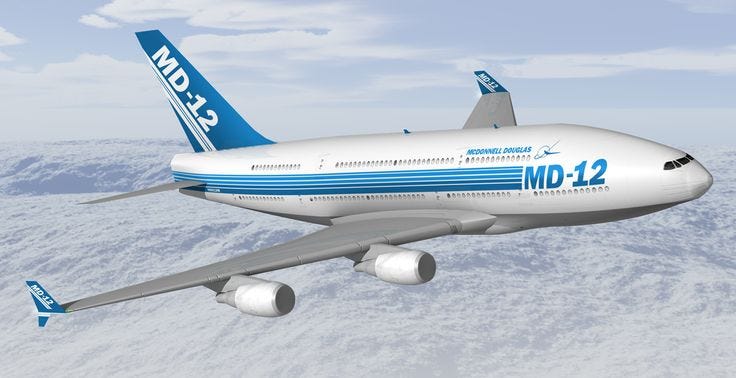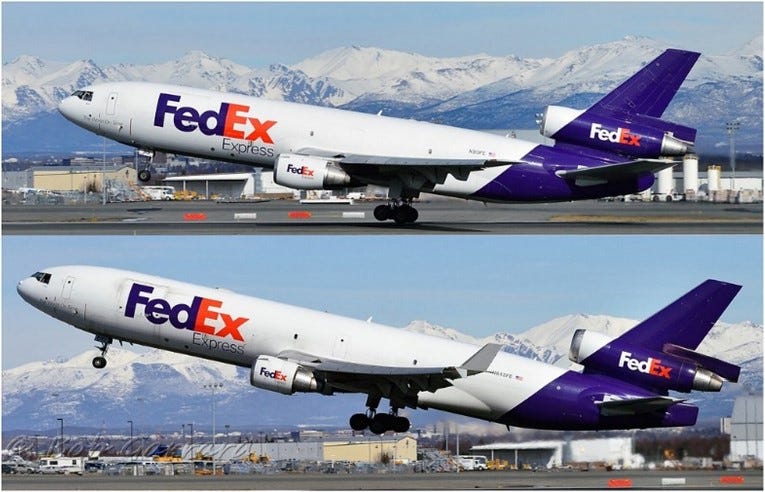Fast Airplanes and Tiny Transistors
Part 2 : Lessons from McDonnell-Douglas
The plane that never was – the MD12 was proposed as a super-jumbo, 500 passenger, double-decker plane in the early 1990s. The plane was deemed too large, uneconomical to build and to operate, did not get any buyers and was never built.
McDonnell Aircraft Corporation was founded in July 1939 in St Louis, Missouri and was known for its military fighter planes. It was a major supplier to the United States defense department. McDonnell-Douglas was formed after the acquisition of Douglas Aircraft Company in 1967. The combination of McDonnell, primarily a defense contractor and Douglas, primarily a commercial aircraft manufacturer was seen as a highly synergistic one that would be able to effectively compete against Boeing. The combined firm would go on to produce 55,000 planes – but by the early 1990s, the company lost control of costs and product quality and failed to innovate. Its customers noticed and dropped orders, and the company was forced to sell itself to rival Boeing in 1997.
This paper provides a closer look at the factors that led to the fall of McDonnell-Douglas.
In the early years of the commercial jet age (1950s), long-range aircraft were built with 4 engines (quad-jets) for added safety and to boost engine thrust. Over time, as engines became increasingly reliable and powerful, tri-jets and twin-jets became more common. For airlines, engine count and passenger capacity would become foundational choices in determining fuel efficiency and operating cost of next generation aircraft.
The Douglas DC8 was a quad-jet, narrow-body, long-range aircraft that began service in 1959. It competed in the market with the Boeing 707, also a quad-jet, narrow-body aircraft with similar range, introduced just the prior year. This was a level playing field between Boeing and Douglas, with each company having a competitive quad-jet engine technology.
Betting on the Wrong Technology : Quad-Jet vs Tri-Jet
Boeing and Douglas (later, McDonnell-Douglas) would eventually diverge in the design choices for their next generation jet aircraft.
The Boeing 747 (1971) was a continuing bet on quad-jet technology. To make up for the added fuel burn and cost of an additional engine, Boeing built a much larger capacity plane – wide-body with double-decker seating at the front of the plane. The 747 had a passenger capacity of 366, extendable up to 467.
The McDonnell-Douglas DC10 (1970) was a bet on tri-jet technology. Douglas assumed that having one less engine would prove to be more efficient over the long run. The DC10 had a much smaller passenger capacity of only 270 but a flying range comparable to the larger 747.
In hindsight, the higher capacity of the 747 more than compensated for the cost of the additional engine. This advantage became more evident as engines became more fuel-efficient over time and the cost of fuel itself dropped after the oil crisis of the 1970s. The DC10 on the other hand was stuck with the smaller passenger carrying capacity. Over time, McDonnell-Douglas created more variants of the DC10 (-10, -30, -40) with different engines and ranges. But it could never win against the runaway success of the Boeing 747.
DC10 : Design Flaws, Poor Timing, and a Price War
Design Flaws: Picking a sub-optimal technology (tri-jet) put McDonnell-Douglas at a structural cost disadvantage. But having flaws in the airplane design itself led to fatal crashes, massive operating losses in the form of lawsuits, legal compensation, repairs, recalls and a huge blow to the company’s safety record and brand. The DC10 was involved in two tragic and fatal accidents (1972 and 1974) that were attributed to a design flaw in its cargo doors. These were followed by the 1979 crash of American Airlines Flight 191 (the deadliest aviation accident in US history), following which the US Federal Aviation Administration (FAA) grounded all US DC10s. While the American Airlines crash was attributed to improper maintenance procedures and not to flaws in the design, the FAA did find that nearly half of the planes failed a test on engine-assembly safety defects. The damage to the reputation of the plane was irreversible and the company announced in 1983 that production of the plane would end due to a lack of orders. Litigation resulting from the DC10 accidents went on for years and cost the company tens of millions of dollars (1970s dollars).
Price Attrition: The DC10 and the competing Lockheed L-1011 were both developed in response to a request from American Airlines and were similar in design, passenger capacity and launch date. As a result, both companies engaged in a war of price attrition, which led to the plane not being profitable for either company! McDonnell Douglas lost money on the plane and Lockheed needed a cash infusion from the US government to save it from bankruptcy.
Poor timing: When McDonnell-Douglas won its huge DC10 sales order from American Airlines in 1968, the market for commercial aviation was heating up and worldwide demand for commercial aircraft was a record high of 724. By the time the DC10 was introduced in 1970, the market was in a slump, and in 1972, demand fell to just 246. Shortly after, the oil crisis of the 1970s put further strain on the commercial airliner business.
The McDonnell-Douglas DC10 tri-jet (left) and the Boeing 767 twin-jet (right). Tri-jets were at a structural cost disadvantage as engines became more efficient and reliable over time.
Staying on the Wrong Technology : Twin-Jet vs Tri-Jet
McDonnell-Douglas realized the limitation of tri-jets in the 1970s itself and started work on a twin-jet version of the DC10. This project, however, was quickly shelved because it was not a simple tweak, and the company did not want to invest in a ground-up new design. Had it done so, it would have set up McDonnell-Douglas to compete well against Boeing and Airbus in later years.
Instead of a course correction, McDonnell-Douglas chose to stay with the tri-jet configuration as it built its next plane, the MD11 (best described as an even larger, stretched version of the DC10). While this saddled the company with the additional cost of a third engine, its competitors innovated and took advantage of improved engine efficiency and reliability by developing long range twin-jets (Boeing 767, 777 and Airbus A330).
The tri-jet was never able to get the same market traction as its twin-jet competitors. The company’s refusal to invest in innovation and failure to adopt superior twin-jet technology put it on a financially unsustainable path. Tragically, the company continued down its path even when it became apparent that the landscape had changed.
The MD11 (below) was, simply put, an even larger, stretched version of the DC10 (top) (source: Link)
MD11 : Failed to Meet Target Specs
Despite the tri-jet disadvantage, the MD11 could have become a successful aircraft, had it delivered on its promised range and fuel efficiency. The competing twin-jet planes (A330 and 767) couldn’t fly long range routes in the early days and so the only option for long haul was the Boeing 747 which had 4 engines and was significantly larger. So, the MD11 could have been a good option for medium capacity, long haul flights – but the airplane simply did not meet its range and fuel burn promises. American Airlines cancelled their order while citing problems with engine performance and airframe, while Singapore Airlines found that the airplane simply could not operate on its desired long haul routes. The airplane was only able to fly 90% of its range target with a full payload; or fly the target range with only 80% of its payload target. Singapore Airlines cancelled their order for 20 MD11s and ordered 20 Airbus planes instead. Even if the MD11 had lived up to its promises, it would have been quickly rendered obsolete with the advent of fuel-efficient twinjets like the 777. MD11 sales never took off and the plane was sold exclusively as a freight plane in later years.
MD12 : An Even Larger Plane!
McDonnell-Douglas made yet another major strategic error. While they were dealing with the fallout of the MD11s failure to meet its range target, the company proposed an even bigger plane. The MD12 was initially proposed as a tri-jet even larger than the MD11 (!) The airline customers rejected that design as it was not fuel efficient over existing aircraft. The company then proposed an even larger stretched version, but with 4 engines and a double-decker configuration – a “super jumbo-jet”. This plane would be much larger and have more capacity than the Boeing 747 but would have a similar range and compete with it. The MD12 proposal was soundly rejected by airlines, received no orders, and was canceled. This rejection left the company without any innovative aircraft design for the 1990s.
It should be noted that the MD12 design was way too ambitious and ahead of its time. Over a decade later, the Airbus A380 realized that vision, but even that airplane proved to be unsustainable and extremely expensive to maintain. Airbus could only sell the aircraft for below production cost and even then, orders declined to the point where the A380 was discontinued and the $25B investment by Airbus was never recouped.
Failed Strategy and Failed Execution
"We got in trouble the old-fashioned way; we earned it. We lost sight of our costs and customers…our financial performance went to hell."
Herbert Lanese, Former CFO of McDonnell-Douglas
The company failed to manage the critical technology inflection from quad-jets to twin-jets and stubbornly placed its bet on an intermediate option (tri-jet) which achieved neither the optimal range nor the optimal fuel burn. They made this blunder not once, but twice and refused to innovate or listen to their customers or to the market. They then failed to execute on their misguided strategy – and produced planes, first with design flaws (DC10) and then with sub-par performance (MD11), which led to a precipitous decline in orders from customers.
To make matters worse, the defense arm of the company made similar blunders when they signed two highly complex contracts (Navy A12 bomber and Air Force C17 transport) at fixed price, implying that they would lose money if the costs exceeded a pre-determined amount. These projects were mismanaged, ran behind schedule and over cost, which further aggravated the company’s finances.
Rather than course-correct their product definition strategy based on their internal reality (execution record, financial health) and the external landscape (technology, competitors, market trends), they chose to stay on a failed strategy of building an even larger plane, the MD12! Failure to gain traction on the MD12 combined with a decline in orders for existing aircraft pushed the company to the edge of bankruptcy.
In December 1996, Boeing announced that it would acquire the flailing McDonnell-Douglas (Link).
The views expressed herein are my own.





McDonald tri-jet Intel bet on quad patterning?
x86 attachment to IDM and adding IFS same as McDonald similar not realizing the pivot to twin engines as superior as is the Fabless - Foundry?
Similar as today can they world really support more than two suppliers TSMC and Samsung, similar to Airbus and Boeing?